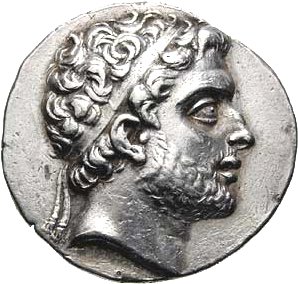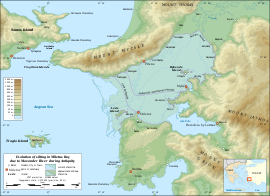
The Battle of Cynoscephalae was an encounter battle fought in Thessaly in 197 BC between the Roman army, led by Titus Quinctius Flamininus, and the Antigonid dynasty of Macedon, led by Philip V, during the Second Macedonian War. It was a decisive Roman victory and marked the end of the conflict.

The Virginia Capes are the two capes, Cape Charles to the north and Cape Henry to the south, that define the entrance to the Chesapeake Bay on the eastern coast of North America.

The Battle of Lade was a naval battle which occurred during the Ionian Revolt, in 494 BC. It was fought between an alliance of the Ionian cities and the Persian Empire of Darius the Great, and resulted in a decisive victory for the Persians which all but ended the revolt.

The Kalinga War was fought in ancient India between the Maurya Empire under Ashoka the Great and Kalinga, an independent feudal kingdom located on the east coast, in the present-day state of Odisha and northern parts of Andhra Pradesh. It is presumed that the battle was fought on Dhauli hills in Dhauli which is situated on the banks of Daya River. The Kalinga War was one of the largest and deadliest battles in Indian history.

A pitched battle or set-piece battle is a battle in which opposing forces each anticipate the setting of the battle, and each chooses to commit to it. Either side may have the option to disengage before the battle starts or shortly thereafter. A pitched battle is not a chance encounter such as a meeting engagement, or where one side is forced to fight at a time not of its choosing such as happens in a siege or an ambush. Pitched battles are usually carefully planned to maximize one's strengths against an opponent's weaknesses and use a full range of deceptions, feints, and other manoeuvres. They are also planned to take advantage of terrain favourable to one's force. Forces strong in cavalry, for example, will not select swamp, forest, or mountain terrain for the planned struggle. For example, Carthaginian General Hannibal selected relatively flat ground near the village of Cannae for his great confrontation with the Romans, not the rocky terrain of the high Apennines. Likewise, Zulu Commander Shaka avoided forested areas or swamps, in favour of rolling grassland, where the encircling horns of the Zulu Impi could manoeuvre to effect. Pitched battles continued to evolve throughout history as armies implemented new technology and tactics.

The Battle of Chios was fought in 201 BC between the fleet of Philip V of Macedon and the combined fleet of Rhodes, Pergamum, Byzantium and Cyzicus.

HMS Cleopatra was a Dido-class cruiser of the Royal Navy. She was built by R. and W. Hawthorn, Leslie and Company, Limited, with the keel being laid down on 5 January 1939. She was launched on 27 March 1940, and commissioned on 5 December 1941.

The Maritime history of Europe represents the era of recorded human interaction with the sea in the northwestern region of Eurasia in areas that include shipping and shipbuilding, shipwrecks, naval battles, and military installations and lighthouses constructed to protect or aid navigation and the development of Europe. Europe is situated between several navigable seas and intersected by navigable rivers running into them in a way which greatly facilitated the influence of maritime traffic and commerce. Great battles have been fought in the seas off of Europe that changed the course of history forever, including the Battle of Salamis in the Mediterranean, the Battle of Gravelines at the eastern end of the English Channel in the summer of 1588, in which the “Invincible” Spanish Armada was defeated, the Battle of Jutland in World War I, and World War II’s U-boat war.
The history of Anatolia can be roughly subdivided into: Prehistory of Anatolia, Ancient Anatolia, Classical Anatolia, Byzantine Anatolia, Ottoman Anatolia and the Modern Anatolia, since the creation of the Republic of Turkey.

The Cretan War was fought by King Philip V of Macedon, the Aetolian League, many Cretan cities and Spartan pirates against the forces of Rhodes and later Attalus I of Pergamum, Byzantium, Cyzicus, Athens, and Knossos.
The Battle of Salyersville, also called Battle of Half Mountain was the largest of the many skirmishes in Magoffin County, Kentucky, during the American Civil War.
Thyrea, also Thyraea, Thyreae or Thyreai (Θυρέαι), was a town of Cynuria, and was fought over between ancient Argolis and ancient Laconia. Its territory was called the Thyreatis (Θυρεᾶτις). According to Pausanias, Thyrea was named after a mythological figure: Thyraeos, the son of Lycaon.
Antisthenes of Rhodes was an ancient Greek historian who lived c. 200 BCE. He took an active part in the political affairs of his country, and wrote a history of his own time, which, notwithstanding his bias towards his native island of Rhodes, is spoken of in terms of high praise by Polybius. He wrote an account of the Battle of Lade and was, according to Polybius, a contemporary with the events he described.
Leucae or Leuce was a small town of ancient Ionia, in the neighbourhood of Phocaea. Leucae was situated, according to Pliny in promontorio quod insula fuit, or, "on an island promontory." From Scylax we learn that it was a place with harbours. According to Diodorus, the Persian admiral Tachos founded this town on an eminence on the sea coast, in 352 BCE; but shortly after, when Tachos had died, the Clazomenians and Cymaeans quarrelled about its possession, and the former succeeded by a stratagem in making themselves masters of it. At a later time Leucae became remarkable for the battle fought in its neighbourhood between the consul Publius Licinius Crassus Dives Mucianus and Aristonicus in 131 BCE. Some have supposed this place to be identical with the Leuconium mentioned by Thucydides; but this is impossible, as this latter place must be looked for in Chios. The site of the ancient Leucae is at Üçtepeler, Izmir Province, Turkey, some distance from the coast. Coins were minted at Leucae in the 3rd century BCE.
Canae was, in classical antiquity, a city in ancient Aeolis, on the island of Argennusa in the Aegean Sea off the modern Dikili Peninsula on the coast of modern-day Turkey, near the modern village of Bademli. Today Argennusa has joined the mainland as the Kane Promontory off the Dikili Peninsula. Canae is famous as the site of the Battle of Arginusae in 406 B.C.

Isaura Palaea, in Latin Isaura Vetus, both meaning 'Old Isaura', and perhaps identical to Isauropolis, was a Roman and Byzantine era town in southern Turkey. The city has been identified with modern Zengibar Kalesi, Bozkır, Konya Province.
Hysiae or Hysiai, also Hysia (Ὑσία), was a garrison town of ancient Argolis, also called the Argeia, Southern Greece during the archaic period. It was located to the southwest of Argos and east of Tegea, on the road between them, at the foot of Mount Parthenium, not far from the Argive border with Laconia. In c. 669 BCE, the First Battle of Hysiae was fought between the Spartans and the Argives, who won to repulse a Spartan invasion of Argolis. It appears to have been destroyed by the Argives, along with Tiryns, Mycenae, and the other towns in the Argeia, after the Greco-Persian Wars; but it was afterwards restored, and was occupied by the Argives in the Peloponnesian War as a frontier-fortress. During the Peloponnesian War, in 417 BCE, the Second Battle of Hysiae was fought, again between the Spartans and the Argives, and resulted in a decisive Spartan victory. The Spartans captured Hysiae and destroyed it; all captured male citizens were executed.
Asea was a town of ancient Arcadia in the district Maenalia, situated near the frontier of Laconia, on the road from Megalopolis to Pallantium and Tegea. According to Greek mythology, Asea is said to be named for Aseatas, son of the Spartan king, Lycaon. During the Greco-Persian Wars, inhabitants of Asea fought in the historic Battle of Plataea (479 BCE). Asea took part in the foundation of Megalopolis, to which city most of its inhabitants removed in 371 BCE; but Asea continued to exist as an independent state, since the Aseatae are mentioned, along with the Megalopolitae, Tegeatae, and Pallantieis, as joining Epaminondas before the Battle of Mantineia in 362 BCE. At a later time, however, Asea belonged to Megalopolis, as we see from the descriptions of Strabo and Pausanias. The city was in ruins in the time of Pausanias, who mentions its acropolis. In its territory, and at the distance of 5 stadia from the city, on the road to Pallantium, were the sources of the Alpheius, and near them those of the Eurotas. The two rivers united their streams, and, after flowing in one channel for 20 stadia, disappeared beneath the earth; the Alpheius rising again at Pagae, and the Eurotas at Belemina in Laconia. North of Asea, on the road to Pallantium, and on the summit of Mount Boreium, was a temple of Athena Soteira and Poseidon, said to have been founded by Odysseus on his return from Troy. City coins have been found dated 196 BCE.
The Ptolemaic navy was the naval force of the Ptolemaic Kingdom and later empire from 305 to 30 BC. It was founded by King Ptolemy I. Its main naval bases were at Alexandria, Egypt and Nea Paphos in Cyprus. It operated in the East Mediterranean in the Aegean Sea, the Levantine Sea, but also on the river Nile and in the Red Sea towards the Indian Ocean.









